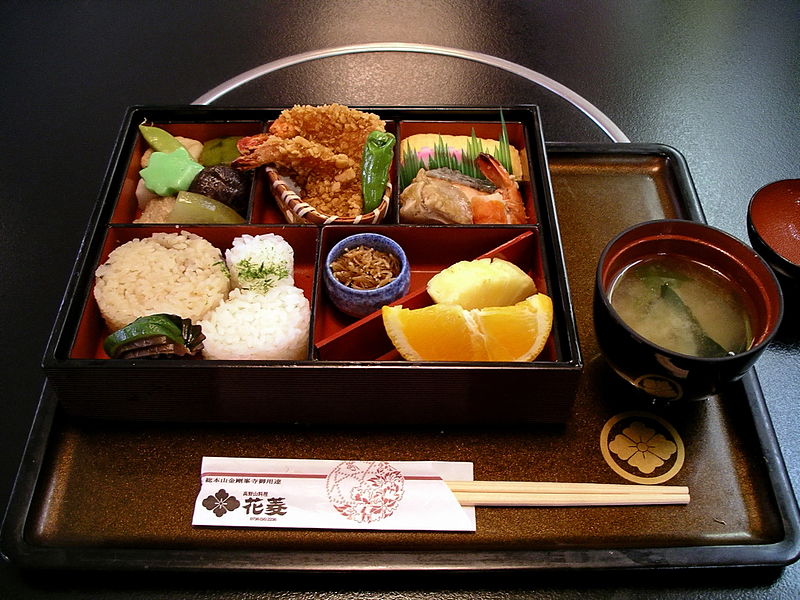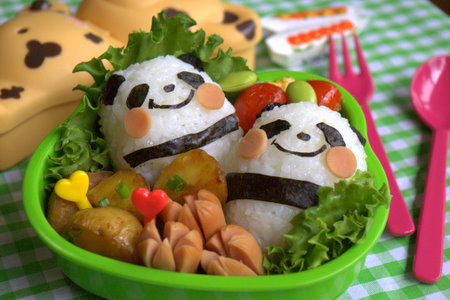| Actualite |
Bento
par Raphael
In a Japanese kindergarten class, on the bullet train to Kyoto, and these days even in restaurants specializing in traditional Japanese cuisine, you can spot the bento box. Sometimes they come in cute, plastic boxes decorated with cartoon characters, and sometimes they come in elegant handmade cedar boxes wrapped in a colorful furoshiki. A packed lunch that features a colorful variety of foods presented creatively within the confines of a small box, the bento is everywhere. Some bento feature a graceful presentation of beautifully arranged seasonal foods that would suit the most refined diner, while others playfully depict plants, animals, and people. The presentation of a bento is just as important as the taste of its many components, and the creativity that is packed onto these small, “edible canvases” is considered an expression of love from the maker of the bento to the person who will eat it.

Although bento boxes have become more elaborate over the centuries, the beginnings of the bento are humble. Simple rations known as “kare-ii” were carried by travelers from the 6th to the 8th centuries. Usually kare-ii consisted of dried rice that could be carried easily from place to place, then soaked in water until it became soft and edible once more. Over time, this evolved into the “nigiri-meshi,” a pressed ball of cooked rice that was later developed to be carried by soldiers on their way to war. In the Edo period, widespread peace made it possible for ordinary people to travel more. By then, bento had evolved to a familiar state: illustrations from the period depict boxed meals that have been brought along on trips and taken to events like blossom-viewing parties.
These Edo-period bento included a variety of luxury foods not commonly eaten at home. In the Chinese tradition, bento included foods that were red, yellow, green, white and black. Not only did the combination of colors look appealing, but the variety also ensured a good nutritional balance. Bento sets in the Edo period were often beautiful and elaborate. Some included compartments for flasks of sake, and drawers for small plates. Handcrafted, lacquered bento sets were a status symbol among the Edo elite who could afford such luxuries.
Kabuki was also becoming popular in the Edo period. A performance of kabuki can stretch from morning until night, so many audience members began to enjoy bento during the intermissions. These theater bento were known as “maku no uchi,” literally meaning “within the curtain,” a reference to the playhouse in which they were enjoyed. The luxurious food offered up by kabuki bento offered an escape from the simple fare that was enjoyed at home by most Edo townspeople. Bento that contain a great variety of luxury foods are still known as “maku no uchi” today, and still call to mind a celebratory mood.
Today, bento are available in all kinds of places. Convenience stores sell some of the simplest and most affordable bento. Usually mass-produced at bento factories, convenience store bento are very popular with people on the go. Much money is spent annually on convenience store bento, and a popular bento can bring booming business to the convenience store chain who sells it. Even when they are not handmade, the convenience and home-style cooking found in bento make them big business.
Train station bento, known as “eki ben” are must-haves for long-distance travelers. Each station and region has its own specialties, so the visiting customer can always experience some local flavor right in the station. Eki-ben are offered in many different whimsical containers. A container shaped like the shinkansen bullet train is popular amongst children and contains foods that appeal to kids, like spaghetti and mini hamburgers. A bento that features pork amongst its contents may be served in a pig-shaped container. One even included a top with a slot in it, so that once the food was consumed, the container could continue to serve the customer at home as a piggy bank. There are also many bento that are given names that evoke Japan’s culture and its past in order to target customers who may want to borrow some of the glamor of ancient warriors or famous beauties.

The most creative bento are usually homemade. Homemakers make bento for their children or spouses to express their feelings, love, and imagination. All kinds of tools, such as flower-shaped vegetable cutters, are deployed to make the fanciful shapes that delight family members at the lunch table. There are many magazines that include bento ideas. The ideas are more than just recipes: they especially focus on fun presentations to make the food appealing and communicate the maker’s love to his or her family. Ideas for bento that include things like octopi made of sausages, jagged-cut eggs, and petal-shaped fish-cake are also shared on the internet, and sometimes even in photo exhibitions.
There are many different types of boxes that bento can be packed in, but the “wappa” is perhaps the most famous. Once, it was common people who carried their food in these oval-shaped cedar or cypress boxes, but now the handmade items are prized for their craftsmanship. Wappa are practical, too. The wood absorbs moisture, keeping the rice from getting soggy, and lacquered insides can help protect the box from stains. These boxes, made with great skill so that they fit together perfectly, are a graceful way to present bento, even today.
Although bento was traditionally meant to be carried along and eaten outdoors or when travelling, in the 20th century, a style of bento that was meant for eating indoors at a restaurant developed. At some “kaiseki” restaurants, which serve elaborate, high-end cuisine, bento-style presentation has become popular. Instead of sending out dishes one course at a time, all are arranged and presented together, as though they were in a bento. The colorful selection and wide variety of food calls the bento to mind, and the convenience is a welcome addition even to elaborate kaiseki cuisine. The simple elegance contained in bento-style kaiseki food makes it a pleasure to eat. From simple travelers’ fare to elegant restaurant cuisine, bento has had a long and delicious evolution, but it continues to epitomize the idea of beauty within the confines of a limited space.
Photo credits:
- http://en.wikipedia.org/wiki/File:Kyaraben_panda.jpg
- http://en.wikipedia.org/wiki/File:Bento_at_Hanabishi,_Koyasan.jpg
| Aucun commentaire |


















